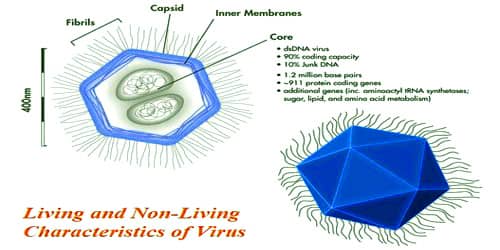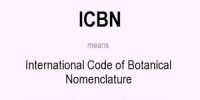A virus is a sub-microscopic element that can contaminate living cells. They are non-cellular organisms, which made up of genetic material and protein that can overrun living cells. They are much lesser, ranging in size from about 20–300 nanometers (nm), though some can be larger. They do not photosynthesize, because they do not have chloroplasts or chlorophyll, whatsoever.
Viruses are not classified as being alive because they don’t have their own mechanism for reproducing. Whether viruses constitute living organisms or simply conglomerations of molecules has been a basis of debate for many years.
The living characteristics of the virus are –
- Every virus is made of either DNA or RNA and protein,
- They can reproduce inside the living cells,
- Like pathogenic bacteria, it also cannot live without living cells,
- Genetic recombination is found to occur in this,
- Mutation is found to occur,
- They have genetic objects,
- They can grow and can increase within host cells
- There are specific races or strains
- They can be transmitted from one host to another.
- They are capable of multiplication in the host.
- They exhibit mutations
- They show irritability because they react to heat, radiation, and chemicals.
- They are capable to reproduce and hence can increase their number.
- They are resistant to antibiotics.
DNA:
- Vaccinia
- T2 Bactoriophage
RNA:
- Tobacco Mosaic Virus (T.M.V)
- Human Immunodeficiency Virus (H.I.V)
Viruses are measured non-living due to following characteristics-
The non-living characteristics:
- It has no distinct cell,
- An individualist virus cannot make am organic activities without living on another living cell,
- They have no cytoplasm, nucleus and another cell organizes and metabolic enzymes,
- Crystal granules can be made,
- They don’t contain both RNA and DNA together.
- They lack metabolic activity outside the living cells.
- They lack ribosomes and cellular enzymes necessary for nucleic acid and protein synthesis.
- They have a lack of cell membrane and cell wall.
- Don’t undergo their own metabolism and no motility
- No energy conversions and no reactions to stimuli
- No reproduction outside living cells
- They can be crystallized and can be precipitated
- The outside of the cells act like inert chemicals
- They don’t show growth, development, nutrition, reproduction, etc.
- Can’t grow in size, shape or something like that. Don’t possess any sort of nutrients.
- Don’t respire or breathe & also don’t excrete.
- Lack of any energy producing system and are totally dependent on their host for their reproduction and metabolism.
- They don’t show cell division, growth, development, nutrition etc.
- They lack cellular organization. Once they infect a cell they take over the machinery of the host cell to replicate themselves.
Viruses are complex assemblies of molecules, including proteins, nucleic acids, lipids, and carbohydrates, but on their own, they can do nothing until they enter a living cell. Without cells, viruses would not be capable to increase. Therefore, viruses are not living things.
The virus is also known as an ultramicroscopic non-cellular disease creating a particle. It causes many diseases to both plant and animals. They do not have cellular respiration, because they are not cells, which is why antibiotics do not affect viruses.












